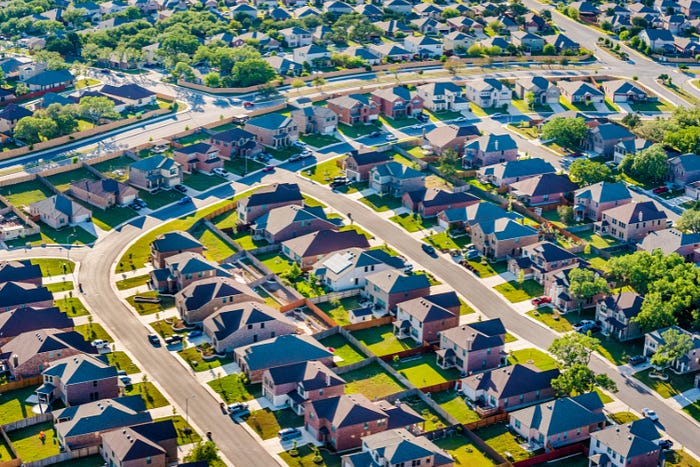The Suburbs Are Making a Comeback. Have We Learned Nothing?
We need villages. We don't need more cars, more subdivisions, or more strip malls.
In the Salt Lake Valley, the world is humming merrily along. The belches and clatters of machines fill the air — the sounds of Inevitable Progress. Housing developments bloom, seemingly overnight, springing from expanses of rock and dirt and tumbleweed.
My children’s father grew up in the Avenues of Salt Lake City, a quiet urban neighborhood with sidewalks and tall, shade-casting trees. His mother rented a string of one-bedroom apartments until she could finally afford a home to call her own. Homes within the city limits were beyond her reach, as they are for so many of us, so she moved to a suburb. Then to another suburb. Then to another suburb after that.
The suburbs that bleed from the southern perimeter of Salt Lake City all look more or less the same. There are the wide, treeless, multi-lane roads, illuminated at night by the glare of fast food drive-throughs. There are big box stores with their vast parking lots, the continuous procession of cars that scuttle from one to the next. There are the empty stretching residential streets lined with too-new houses and too-small trees, and the people inside, nearly always inside, basking in their square footage, surrounded by All Their Things.
Like my children’s father, I grew up in an urban neighborhood where people walked places. The streets were just wide enough for two cars to comfortably pass one another and each house was its own unique entity, a different color, style, and height from the house next door. My childhood neighborhood had a settled feeling, like an old-growth forest, a place where roots had been laid. The ecosystem evolved over the years, but the changes were steady and layered. An old house decaying over there, a new house sprouting here.
The neighborhood where my children’s grandmother now lives reminds me of the reforested areas I sometimes see on hillsides that have been logged — tidy rows of trees, all the same height, the same breadth, the same distance apart. It both looks like a forest and doesn’t look like a forest. Your brain tells you it’s a forest because it’s a cluster of trees, but your brain also tells you that something is… off.
Whenever I spend a stint in the suburbs, usually when visiting extended family or, years ago, when living at my boyfriend’s parents’ house for a month in Rhode Island, my brain can’t shake a persistent feeling of unease. My boyfriend’s parents lived on Peach Tree Lane, and I tried to convince myself that there was nothing wrong with this quiet street with this lovely name, which may or may not have actually boasted peach trees.
Then I went for a run — back in the days before GPS-enabled smartphones — and I got lost amongst all the various lanes paying tribute to various fruit trees, and all the streets and houses looked the same. Every time I turned a corner, I was sure I’d come across the right street, because it looked exactly like the street where my boyfriend’s parents lived, and I felt an initial wave of certainty and recognition, only to be overwhelmed by a second wave of disorientation and alarm, like that moment when someone you’re certain you know turns around and the face you see is not at all the face you’re expecting to see.
As I became more panicked, I began to wonder where all the people were. Did this neighborhood have a heart where residents gathered? Did anyone roam the streets by foot? I staggered blearily through the suburban dystopia that looked suddenly menacing in its sameness, its emptiness, and by the time I happened upon my boyfriend’s parents’ house, I had almost managed to convince myself that the apocalypse had taken place somewhere around mile three and I was the last human left on Earth.
Keep reading with a 7-day free trial
Subscribe to Mom, Interrupted to keep reading this post and get 7 days of free access to the full post archives.




